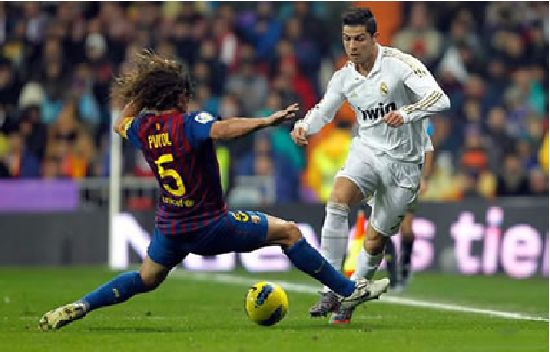7.3: Examples
- Last updated
- Jun 15, 2023
- Save as PDF
- Page ID
- 85792

- Christopher Duston, Merrimack College
- University of Arkansas via University of Arkansas Libraries
( \newcommand{\kernel}{\mathrm{null}\,}\)
Whiteboard Problem 7.3.1: Nutmeg

In soccer, a ``nutmeg'' is when you kick the ball through the legs of an opponent, thouroughly humiliating them. In the figure, Ronaldo nutmegs Puyol by kicking the ball (with a mass of 435 g and radius of 11.5 cm) at a velocity of 1.75 m/s.
- If the ball is rolling along the ground without slipping, what is the angular momentum of the ball about its center of mass?
- When the ball passes through Puyol's legs, what is the angular momentum of the center of mass of the ball relative to his head? Puyol is 5'10'' (1.78 m) tall.
- Puyol spins around after the nutmeg and sees the ball a distance 1.15 m along the ground behind him, still rolling with the same velocity. What is the angular momentum of the center of mass of the ball now?
Example 7.3.2: Calculating Torque
Four forces are shown in Figure 7.3.4 at particular locations and orientations with respect to a given xy-coordinate system. Find the torque due to each force about the origin, then use your results to find the net torque about the origin.
Strategy
This problem requires calculating torque. All known quantities––forces with directions and lever arms––are given in the figure. The goal is to find each individual torque and the net torque by summing the individual torques. Be careful to assign the correct sign to each torque by using the cross product of →r and the force vector →F.
Solution
Use |→τ| = r⊥F = rFsin θ to find the magnitude and →r=→r×→F to determine the sign of the torque.
The torque from force 40 N in the first quadrant is given by (4)(40)sin 90° = 160 N • m.
The cross product of →r and →F is out of the page, positive.
The torque from force 20 N in the third quadrant is given by −(3)(20)sin 90° = − 60 N • m.
The cross product of →r and →F is into the page, so it is negative.
The torque from force 30 N in the third quadrant is given by (5)(30)sin 53° = 120 N • m.
The cross product of →r and →F is out of the page, positive.
The torque from force 20 N in the second quadrant is given by (1)(20)sin 30° = 10 N • m.
The cross product of →r and →F is out of the page.
The net torque is therefore τnet=∑i|τi| = 160 − 60 + 120 + 10 = 230 N • m.
Significance
Note that each force that acts in the counterclockwise direction has a positive torque, whereas each force that acts in the clockwise direction has a negative torque. The torque is greater when the distance, force, or perpendicular components are greater.
Example 7.3.3: Calculating Torque on a rigid body
Figure 7.3.5 shows several forces acting at different locations and angles on a flywheel. We have |→F1| = 20 N, |→F2| = 30 N, |→F3| = 30 N, and r = 0.5 m. Find the net torque on the flywheel about an axis through the center.
Strategy
We calculate each torque individually, using the cross product, and determine the sign of the torque. Then we sum the torques to find the net torque. Solution We start with →F1. If we look at Figure 7.3.5, we see that →F1 makes an angle of 90° + 60° with the radius vector →r. Taking the cross product, we see that it is out of the page and so is positive. We also see this from calculating its magnitude:
|→τ1|=rF1sin150o=(0.5m)(20N)(0.5)=5.0N⋅m.
Next we look at →F2. The angle between →F2 and →r is 90° and the cross product is into the page so the torque is negative. Its value is
|→τ2|=−rF2sin90o=(−0.5m)(30N)=−15.0N⋅m.
When we evaluate the torque due to →F3, we see that the angle it makes with →r is zero so →r×→F3 = 0. Therefore, →F3 does not produce any torque on the flywheel.
We evaluate the sum of the torques:
τnet=∑i|τi|=5−15=−10N⋅m.
Significance
The axis of rotation is at the center of mass of the flywheel. Since the flywheel is on a fixed axis, it is not free to translate. If it were on a frictionless surface and not fixed in place, →F3 would cause the flywheel to translate, as well as →F1. Its motion would be a combination of translation and rotation.
Exercise 7.3.4: Ship Run Aground
A large ocean-going ship runs aground near the coastline, similar to the fate of the Costa Concordia, and lies at an angle as shown below. Salvage crews must apply a torque to right the ship in order to float the vessel for transport. A force of 5.0 x 105 N acting at point A must be applied to right the ship. What is the torque about the point of contact of the ship with the ground (Figure 7.3.6)?

